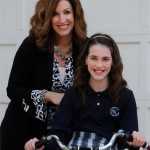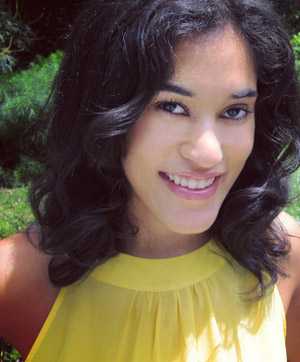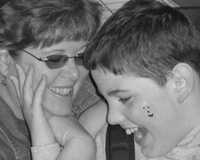My Story
Real Stories from People living with Cerebral Palsy
On this Page
Sandy’s Story
Sandy is the parent of a child with cerebral palsy and the Board President of Gio’s Garden, a non-profit organization in Wisconsin whose mission is to nurture and strengthen families with special needs children by increasing their access to services. Before becoming a full-time mother and advocate, Sandy worked for 14 years in depression research.
“Every aspect of our lives is shaped by the over 1200 hours a year it takes to take our daughter with cerebral palsy to her more than 200 appointments with 9 doctors and 5 therapists; deal with insurance; find needed equipment and services; do therapy with her at home; address her behavioral issues; spend extra time on her school work; supervise almost everything she does to maintain her safety and maximize her independence; and make the extra time for her to do things other kids do so quickly and easily. It means staying where we have supportive family and have learned how to navigate systems; giving up my career because of my family’s needs; and becoming an advocate for families with children with special needs. It has forced us to acquire new skills and re-focused our lives. It has made us intentional parents who constantly think about how we can keep our daughter’s needs from taking over our family while making sure her brother’s needs are also met. It has brought us closer together as a family, taught us the value of family and community, and helped us learn to cherish every little thing about both of our children.
Having a child with special needs changed everything: because I now know the effect raising a child with special needs has on the entire family and how hard it is to learn about and access the multitude of needed services, I feel compelled to help other families through this process any way I can. My husband and I have all the advantages a parent of a child with special needs could hope for—supportive family and friends, relevant education and training, a good income, and good insurance—yet we have still experienced challenges. If we have not had an easy time of it, how do families who are not as fortunate as we are do it? And how could I sit back and watch that happen when the focus of the career I gave up for the sake of my special needs family had been resilience, stress, and coping?
Although cerebral palsy is a disorder that can impact any and all aspects of a person, it does not define who that person is. He or she still wants a high quality of life and parents of kids with cerebral palsy want the same thing for and to do the same things with their kids that other parents want.”
CDC would like to thank Sandy for sharing her personal story.
Cynthia’s Story

“Is this hopeless?” Cynthia Frisina Gray asked upon learning about her daughter’s diagnosis of cerebral palsy in 2001. Cynthia knew there was a possibility that Cathryn could have problems—she was born prematurely—but she never imagined the difficulties that lay ahead.
Though she seemed fine at first, after several months, Cynthia began to notice that sometimes Cathryn seemed very floppy, almost like a rag doll. Other times, she seemed to stiffen. “I knew she wasn’t hitting the same growth and motor milestones like my older daughter,” said Cynthia.
Several doctor’s appointments later, she finally received a diagnosis of cerebral palsy. Cynthia immediately went to the Internet searching for anything and everything about cerebral palsy. She felt frustrated by the limited information she could find that specifically addressed the needs of parents.
Cynthia expressed her frustrations to Cathryn’s orthopedic surgeon, who connected Cynthia with another parent of a child with cerebral palsy: Anna Marie Champion. Cynthia and Anna Marie set out to understand how they could help educate other families about prevention and treatment. But they weren’t sure where to start. They read about spina bifida, a disabling birth defect of the spine, and about the discovery that folic acid can help reduce it. “That’s what we want—our ‘folic acid’—something that could help prevent cerebral palsy,” Cynthia said. “We found out that we can’t prevent and treat cerebral palsy without understanding the root causes of it.” Tracking the number of children with cerebral palsy is the first step to understanding the characteristics and finding the root causes.
“Watching Cathryn go through the pain of two major orthopedic surgeries at such a young age is hard, but we know it’s necessary to help her walk,” said Cynthia. Today, Cathryn is thriving but her mother knows there will be many challenges ahead. “Like all parents, I hope and dream about my daughter going to college and having a fulfilling life,” said Cynthia. “I also hope that one day we know what causes cerebral palsy so that we can help others.”
CDC would like to thank Cynthia and Reaching for the Stars for sharing this personal story.
Dalila’s Story

“I have mild spastic diplegia. My cerebral palsy (CP) made me the person I am today. It has shown me that there is strength in the weak and a world full of outsiders.
Since I grew up unaware of my CP diagnosis, my younger self was only conscious of the fact that my stiff muscles made it taxing for me to walk straight and for long distances, to wear certain shoes, and to participate in vigorous activities. I now realize that these difficulties were strongly magnified by the negative emotions they produced. Feeling as though I did not fit in and devoting energy to try to mask that very fact caused more pain than the tangible, physical aches. I did not fully understand why my body could not move the way most kids’ could, and my confusion only worsened my perception.
As a coping mechanism, I ignored my responsibilities to stretch my leg muscles. I hoped that if I didn’t acknowledge my complications, then maybe one day they would just evaporate. I am certain that I would not have increased flexibility in my muscles without my family’s support and their reminders to stretch. My mother took me to physical therapy sessions every week and my older brother, Christopher, helped make my assigned stretches become part of my routine. Christopher, an athlete, understood the benefits and rewards reaped from exercising and targeting particular muscles in order to strengthen them. He and I would watch television in our living room regularly; he would use the time to stretch and invited me to do so too. At the time, I felt as if my condition had already defeated me and, so, completing the stretches seemed pointless. But, for a long while, there in that living room alongside my older brother was the only setting where I felt comfortable doing my assigned stretches because it was the only place where I did not feel alone in my journey. Christopher gave me exactly what I needed then– the courage to work on myself.
After discovering I am part of the CP community, I learned that CP does not look the same on every diagnosed person. “Cerebral Palsy” is a broad term used to describe various conditions. For example, those with quadriplegia are affected in both arms and legs; those with hemiplegia have only one side of the body affected; and those with diplegia are affected in both legs. Further, there are different types, like, spastic CP which describes tight muscles, dyskinetic CP which denotes spasms, and ataxic CP which describes shakiness. I would recommend that family members of those with CP use available resources, like the Centers for Disease Control and Prevention (CDC), to remain educated on the most recent statistical findings and utilize that information for the benefit of their loved one. Equally as important, however, I also suggest they do what my brother did for me: simply be there in any way they can.
I started the Young Professionals Committee (YPC) within the Cerebral Palsy International Research Foundation (CPIRF) to be an example for other young adults who may not realize that CP is an idiosyncratic condition. Discovering my CP helped me realize that I am strong. I hope my work for the YPC helps others affected by CP find their strength and courage as well. I am continuously inspired by the possibility of making a difference, and potentially improving the lives of others with CP. I hope for a day when people with CP are understood and embraced by not only those who are somehow connected to it, but also by the general public.”
Sam’s Story

In 2011, a severe ice storm hit the Midwest, leaving Mary and her family without power, heat, or a reliable car. Mary’s son, Sam, has spastic quadriplegia cerebral palsy. Cerebral palsy is a group of disorders that can affect a person’s ability to move and maintain balance and posture. Sam requires a specialized wheelchair and a wheelchair-accessible van in order to move from place to place. But during the ice storm, Mary’s van was damaged, keeping her from taking her son to a place where he could receive proper medical attention in a safe environment.
Mary quickly turned to her local community for help. “I called the sheriff’s office on that day, and was told to take him to the hospital,” she says. She soon realized that there was not an emergency plan in place to provide transportation for people in wheelchairs to help them get to shelters or the hospital. Without transportation, Mary and Sam were left stranded in their home. Mary encourages families with a child with a special health care need who could face similar emergencies to have an escape plan in place. “Have a set plan for transportation and a place that is safe and able to take care of your child.”
CDC would like to thank Mary and Family Voices for sharing this personal story.
If you would like to share your personal story, please contact us at cdcinfo@cdc.gov
- Page last reviewed: February 3, 2017
- Page last updated: May 2, 2016
- Content source:



 ShareCompartir
ShareCompartir